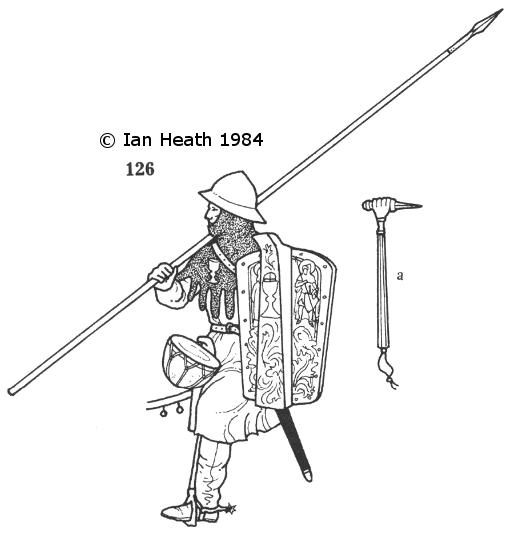
Try Amazon Audible Plus
HUSSITE CAVALRYMAN
An extract from Armies of the Middle Ages, Volume 2by Ian Heath



126. HUSSITE CAVALRYMAN
Hussite cavalry were provided both by those of their movement who had previously served as elements of German, Bohemian and Silesian lances, and by the retainers of such Bohemian noblemen as supported the Hussite revolt. Initially many of the former category had to be mounted on unhitched wagon horses on the field of battle, but later their horses were comprised largely of stock either captured from the Germans or Catholic Bohemian lords, or else purchased in Hungary. With the exception of the few landed gentry amongst them, and of the feudal lords and wealthier burghers of Prague, most Hussite cavalry wore incomplete harness usually comprising a helmet, mail hood and haubergeon supplemented by some plate. The later 'Jena Codex' shows even more lightly-equipped Hussite horsemen, seemingly crossbow-armed, who wear only a sallet (a type of helmet only first recorded in Bohemian sources in 1441, though it had probably in fact appeared there at much the same time as in Germany, ie, the 1420s).
Note that the shield of the figure depicted here is again a pavise, this being the characteristic shield of a Bohemian soldier (so much so that it is usually mistakenly regarded as being of Bohemian origin; for its true origins see figure 142). Its principal identifying features were its rectangular or near-rectangular shape, usually wider at the top than at the bottom, and the raised vertical rib, most often box-shaped. Arms usually comprised lance or crossbow and sword. Other popular sidearms included axe and mace, in particular a variety of the latter called a fist-and-dagger mace, really a war-hammer which took the form of a fist clutching a dagger as shown in 126a, which is a 14th century example. Jan Zizka himself customarily carried such a weapon, as is confirmed by several 15th century illustrations. A 15th century source describes how the people of Hradec decided to have Zizka painted on their banner 'riding a white horse, in knightly array, with a mace as his weapon, just as he rode when he was alive.'
Note the small drums to either side of this figure's saddle, which along with trumpets were used to control the Hussite army's battlefield movements. One Hussite document says: 'When the trumpets sound they attack with gusto, and when the drums play they should come to a halt as quickly as possible and cease chasing the enemy.' According to popular legend Zizka's own skin was made into such a drum after his death, so that when it was beaten his enemies would still be frightened of him.